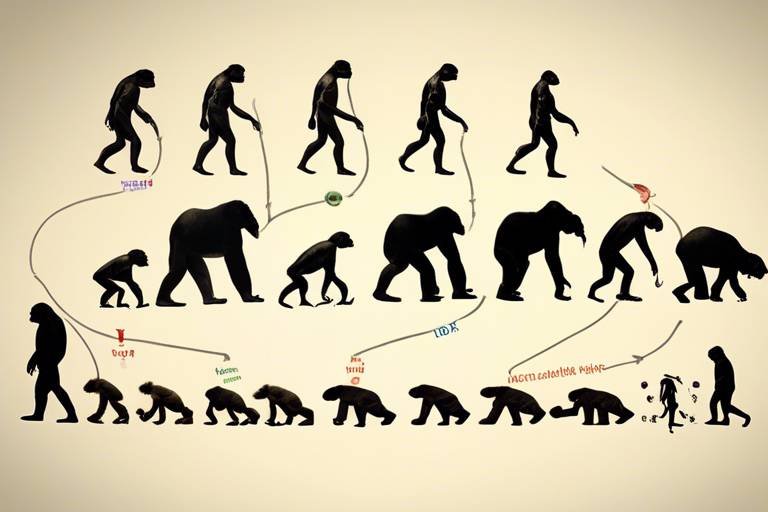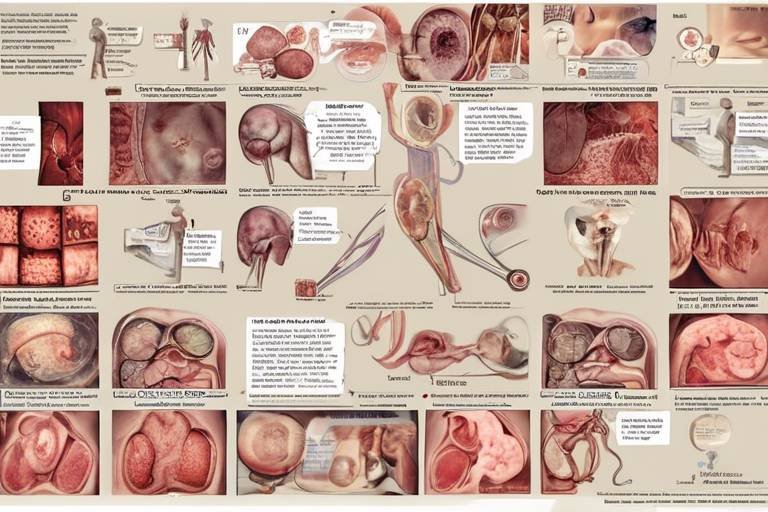The Philosophical Groundwork of Cybernetics
Cybernetics, at its core, is a fascinating field that intertwines philosophy, systems theory, and technology, creating a rich tapestry of ideas that challenge our understanding of both the natural and artificial worlds. As we delve into the philosophical groundwork of cybernetics, we uncover profound implications for how we perceive systems, feedback mechanisms, and the intricate relationship between humans and machines. This exploration is not just an academic exercise; it has real-world applications that affect our daily lives, from the way we interact with technology to the ethical dilemmas we face in an increasingly automated world.
So, what exactly is cybernetics? It’s more than just a fancy term for technology; it’s a lens through which we can view the world as a complex web of interactions. Imagine a bustling city: every traffic light, vehicle, and pedestrian is part of a larger system where communication and feedback loops govern behavior. Just as a city thrives on the flow of information, cybernetics emphasizes the importance of communication and control in both living organisms and machines. This perspective allows us to reflect on how systems operate, adapt, and evolve over time.
As we journey through this landscape, we’ll encounter key philosophical concepts that form the backbone of cybernetics. These concepts invite us to rethink traditional boundaries and embrace a more holistic view of reality. For instance, the idea of self-organization suggests that systems can spontaneously arrange themselves into organized structures without external direction. Think of a flock of birds: they move in unison, creating mesmerizing patterns, yet no single bird is in charge. This emergent behavior is a hallmark of complex systems and speaks volumes about the interconnectedness of all things.
In this article, we will explore the origins of cybernetics, tracing its historical roots and the key figures who have shaped its development. We’ll also dive into the philosophical concepts that inform cybernetics, such as systems theory and feedback mechanisms, before examining the evolving relationship between humans and machines. As we navigate these topics, we’ll uncover the ethical considerations that arise as technology continues to advance at an unprecedented pace.
Ultimately, the philosophical groundwork of cybernetics challenges us to rethink our roles within these systems. Are we merely operators of machines, or are we co-creators in a dance of intelligence that spans both biological and artificial realms? As we ponder these questions, we must remain vigilant about the implications of our technological creations. The journey into the world of cybernetics is not just an academic pursuit; it’s a vital exploration of what it means to be human in an age of machines.
- What is cybernetics? Cybernetics is the interdisciplinary study of systems, control, and communication in animals and machines, emphasizing the feedback loops that govern behavior.
- Who are the key figures in the development of cybernetics? Notable contributors include Norbert Wiener, who coined the term, and other influential thinkers like Ross Ashby and Gregory Bateson.
- How does cybernetics relate to systems theory? Systems theory serves as a foundational element of cybernetics, focusing on the interconnectivity and collective behavior of components within a system.
- What ethical challenges does cybernetics pose? Ethical considerations include concerns about autonomy, privacy, and the societal impacts of increasingly intelligent systems.

The Origins of Cybernetics
Cybernetics, a term coined by Norbert Wiener in the 1940s, represents a fascinating intersection of various disciplines, including engineering, biology, and philosophy. This field emerged in a historical context where the rapid advancements in technology were reshaping our understanding of systems and control. Imagine a time when machines were beginning to mimic human functions—this was the backdrop against which cybernetics was born. Key figures like Wiener, along with others such as Ross Ashby and Gregory Bateson, contributed significantly to its development, each bringing unique perspectives that enriched the field.
The interdisciplinary nature of cybernetics is one of its most striking features. It draws from diverse areas such as mathematics, biology, and cognitive science, creating a rich tapestry of ideas that challenge traditional boundaries. For instance, the principles of feedback and self-regulation found in biological systems were adapted to understand mechanical systems, allowing for a deeper comprehension of how these systems could not only function but also evolve. This blend of disciplines led to groundbreaking theories that would later influence various domains, such as artificial intelligence and systems theory.
To better understand the origins of cybernetics, it's essential to recognize the historical milestones that paved the way for its emergence. Here are some pivotal moments:
- 1943: The publication of the seminal paper "A Logical Calculus of the Ideas Immanent in Nervous Activity" by Warren McCulloch and Walter Pitts, which laid the groundwork for neural networks.
- 1948: Norbert Wiener's book "Cybernetics: Or Control and Communication in the Animal and the Machine" was published, defining the field and its key concepts.
- 1950s-1960s: The development of the first feedback control systems and the exploration of how these principles could be applied to both machines and living organisms.
The interplay between human thought and machine capabilities also played a crucial role in the evolution of cybernetics. This relationship sparked questions about autonomy and control—who is really in charge, the human or the machine? Such inquiries not only shaped the philosophical underpinnings of cybernetics but also paved the way for future discussions about artificial intelligence and robotics. As we delve deeper into this fascinating field, we begin to see how the origins of cybernetics are not just about machines but about understanding ourselves in relation to those machines.
In summary, the origins of cybernetics are steeped in a rich historical context characterized by groundbreaking ideas and interdisciplinary collaboration. The contributions of key figures helped to forge a path that continues to influence our understanding of complex systems today. As we explore further into the philosophical concepts that underpin cybernetics, we will discover how these foundational ideas continue to shape our interactions with technology and the world around us.

Key Philosophical Concepts
When we dive into the fascinating world of cybernetics, we encounter a rich tapestry of philosophical concepts that not only shape our understanding of this field but also challenge our perceptions of reality itself. At the heart of cybernetics lies the idea of systems thinking, which encourages us to view the world not as isolated components, but as interconnected networks where each part plays a vital role in the whole. Imagine a spider web; if one strand is pulled, the entire web responds. This interconnectedness is crucial for grasping the complexities of both biological and artificial systems.
Another pivotal concept is self-organization. This is the remarkable ability of a system to structure itself without external guidance. Think of a flock of birds flying in perfect formation; no single bird is directing the others, yet they all move in harmony. This principle is vital in understanding how systems evolve and adapt over time, reinforcing the idea that order can emerge from chaos. It’s a bit like how a group of friends can spontaneously decide to form a band; each person contributes their unique skills, and together they create something beautiful without a formal leader.
Central to cybernetics is also the notion of feedback loops. These loops are the mechanisms through which systems learn and adapt. In biological terms, consider how your body reacts when you touch something hot. You withdraw your hand almost instinctively, thanks to a feedback loop that informs your brain of the danger. In artificial systems, feedback mechanisms work similarly; they allow machines to adjust their operations based on the outcomes of their actions. This adaptability is what makes cybernetic systems so powerful and relevant in today’s technology-driven world.
Delving deeper into these concepts, we find that systems theory serves as the backbone of cybernetic principles. It emphasizes the interconnectivity of components within a system, highlighting how their collective behavior can lead to unexpected outcomes. This is often illustrated through the concept of emergent properties, where the whole is greater than the sum of its parts. For instance, in a bustling city, the traffic flow is not simply the result of individual cars moving; it emerges from the complex interactions between drivers, traffic lights, and road conditions.
Understanding the relationships between different systems is paramount in cybernetics. The way one system influences another can create a ripple effect, much like how a small stone thrown into a pond creates waves that spread outward. This interconnectedness fosters a holistic perspective, urging us to consider how changes in one area can have profound impacts elsewhere. For example, environmental changes can affect economic systems, which in turn can influence social structures. Recognizing these connections allows us to better anticipate outcomes and make informed decisions.
As we explore the realm of complexity, we realize that it often arises from simple interactions within systems. This is where the magic of emergence happens. Take a look at nature: a single ant may seem insignificant, but together, ants can create intricate colonies with complex social structures. In cybernetics, understanding these emergent properties is crucial for modeling how systems function and evolve over time. It’s a reminder that sometimes, the most profound insights come from observing how simple elements interact to create something extraordinary.
Feedback mechanisms are the lifeblood of cybernetic systems. They are the processes that enable adaptation and learning, whether in living organisms or artificial constructs. Imagine a thermostat in your home; it constantly measures the temperature and adjusts the heating or cooling system accordingly. This simple feedback loop keeps your environment comfortable, illustrating how feedback can lead to optimal functioning. In larger contexts, such mechanisms empower organizations to adapt to market changes, ensuring they remain relevant and effective.
In conclusion, the key philosophical concepts underpinning cybernetics—systems thinking, self-organization, feedback loops, and the intricacies of interconnectedness—invite us to rethink how we perceive and interact with the world around us. They challenge us to see beyond the surface and appreciate the complex web of relationships that define our existence.
- What is cybernetics? Cybernetics is the interdisciplinary study of systems, control, and communication in animals and machines.
- How does systems thinking apply to cybernetics? Systems thinking emphasizes the interconnectivity of components within a system, allowing for a holistic understanding of complex interactions.
- What are feedback loops? Feedback loops are processes through which systems receive information about their performance and make adjustments accordingly.
- Why is self-organization important? Self-organization allows systems to adapt and evolve without external control, leading to innovative solutions and resilience.

Systems Theory
At the heart of cybernetics lies , a framework that helps us understand the intricate web of interactions between various components within a system. Imagine a bustling city; each vehicle, pedestrian, and traffic signal plays a role in the overall flow of movement. Just like that, in any system—be it biological, mechanical, or social—every element interacts with one another, creating a dynamic environment where the whole is greater than the sum of its parts. This interconnectedness is crucial for grasping how systems behave and adapt.
Systems theory posits that to truly understand a system, we must look beyond individual components and focus on their relationships. For instance, consider an ecosystem where plants, animals, and microorganisms coexist. Each organism contributes to the ecosystem's health, and changes in one part can ripple through the entire system, affecting everything from nutrient cycles to population dynamics. This principle of interconnectedness is a cornerstone of cybernetics, emphasizing that systems are not isolated entities but rather part of a larger network.
One of the fascinating aspects of systems theory is the concept of emergence. This refers to how complex behaviors and properties arise from simple interactions. Think of a flock of birds; individually, each bird follows basic rules, such as aligning with neighbors and avoiding collisions. Yet, when they come together, they create mesmerizing patterns and movements that seem almost choreographed. This phenomenon illustrates how emergent properties are vital for understanding cybernetic processes, as they often lead to unexpected outcomes that cannot be predicted by analyzing components in isolation.
Moreover, systems theory encourages a holistic perspective, urging us to consider the context in which a system operates. By examining the environment, feedback loops, and external influences, we can gain insights into how systems evolve over time. For example, in a corporate setting, the interactions between employees, management, and external stakeholders shape the organization's culture and performance. Recognizing these relationships allows for better decision-making and adaptability, which are essential in today's fast-paced world.
In summary, systems theory serves as a fundamental backbone for cybernetic principles. It highlights the importance of understanding the intricate relationships between components within a system, the emergence of complex behaviors, and the need for a holistic approach to problem-solving. As we navigate the complexities of our interconnected world, embracing systems thinking can empower us to create more effective and adaptive solutions.
- What is systems theory? - Systems theory is a framework that studies the interactions and relationships between various components within a system, emphasizing the importance of understanding the whole rather than just the individual parts.
- How does emergence relate to systems theory? - Emergence refers to the complex behaviors and properties that arise from simple interactions within a system, highlighting how the collective behavior can be more significant than the sum of its parts.
- Why is a holistic perspective important in systems theory? - A holistic perspective allows us to consider the broader context in which a system operates, leading to better understanding and adaptability in decision-making processes.

Interconnectedness of Systems
The concept of interconnectedness in systems is a fundamental principle in cybernetics that emphasizes how various components within a system interact with one another. Imagine a bustling city, where every street, building, and person plays a role in the overall functionality of the urban environment. Just like in a city, systems in cybernetics are not isolated entities; they are part of a larger web of relationships that influence and shape each other. This interconnectedness is crucial for understanding how systems operate and evolve over time.
In cybernetic terms, interconnected systems can be seen as networks where each node (or component) contributes to the whole. These nodes communicate and share information, leading to a dynamic interplay that can result in unexpected outcomes. For instance, consider an ecosystem where plants, animals, and microorganisms interact. The health of one species can directly impact others, showcasing how changes in one part of the system can ripple through the entire network. This is often referred to as a feedback loop, where the output of one component becomes the input for another, creating a cycle of interaction.
Understanding the interconnectedness of systems also highlights the importance of a holistic perspective. When we examine systems in isolation, we risk missing out on critical interactions that define their behavior. For example, in the realm of technology, the relationship between software and hardware is a prime illustration of interconnectedness. Changes in software can lead to new functionalities in hardware, and vice versa, demonstrating that the evolution of one component can significantly influence the other. This interplay is why interdisciplinary approaches are vital in cybernetics, as they allow for a comprehensive analysis of how different systems affect each other.
Moreover, interconnectedness fosters resilience. Systems that are well-connected can adapt more readily to changes and challenges. For example, think of a social network where individuals support each other; when one person faces a challenge, the collective strength of the network can help them overcome it. In contrast, isolated systems may struggle to adapt, leading to failure or collapse. This principle can be seen in various domains, from ecological systems to technological infrastructures.
To summarize, the interconnectedness of systems is not just a theoretical concept; it is a practical framework that helps us understand the complexities of the world around us. By recognizing the relationships between different components, we can better appreciate how systems function, adapt, and thrive in a constantly changing environment. In the context of cybernetics, this interconnectedness is a powerful tool for innovation, collaboration, and resilience.

Complexity and Emergence
When we talk about complexity and emergence in the realm of cybernetics, we’re diving into a fascinating world where simple interactions can lead to astonishingly intricate outcomes. Imagine a bustling city: at first glance, it might seem chaotic, but beneath the surface lies a complex web of interactions among its inhabitants, infrastructure, and environment. This idea reflects how complex systems operate, where the whole is often greater than the sum of its parts.
In cybernetics, complexity arises from the interactions within a system. Each component, whether it’s a living organism or a machine, contributes to the overall behavior of the system. This leads us to the concept of emergent properties, which are characteristics that manifest when components interact in a certain way. For instance, consider how individual neurons in the brain work together to create consciousness. Alone, they perform simple tasks, but together, they give rise to thoughts, emotions, and decisions. This phenomenon is not just limited to biological systems; it can also be observed in artificial systems, such as networks of computers that can learn and adapt based on their interactions.
To better understand this concept, let’s break it down into a few key points:
- Interactions Matter: The way components interact can lead to unexpected results. For example, in an ecosystem, the relationship between predators and prey can create a balance that supports diverse life forms.
- Non-linearity: In complex systems, small changes can lead to disproportionately large effects. This is often referred to as the "butterfly effect," where a minor event can trigger a major outcome.
- Adaptive Behavior: Systems are not static; they evolve over time based on interactions and feedback. This adaptability is crucial for survival, whether in nature or in technology.
Moreover, the study of complexity and emergence has profound implications for cybernetics. By understanding how simple rules can lead to complex behaviors, researchers can design better algorithms and systems that mimic these natural processes. For example, artificial intelligence systems that learn from their environment can become more efficient and effective by mimicking the emergent behaviors found in nature.
In conclusion, complexity and emergence are not just academic concepts; they are vital to understanding how systems operate in our world. By embracing these ideas, we can unlock new potentials in technology, biology, and beyond, leading us towards a future where human and machine collaboration is not only possible but also profoundly enriching.
- What is emergence in cybernetics? Emergence refers to properties or behaviors that arise from the interactions of simpler components within a system, leading to complex outcomes that cannot be predicted by examining the parts in isolation.
- How does complexity affect system behavior? Complexity can create non-linear relationships where small changes can lead to significant effects, making systems adaptive and dynamic.
- Can artificial systems exhibit emergent behavior? Yes, artificial systems can demonstrate emergent behavior, especially in fields like artificial intelligence, where simple algorithms can lead to complex decision-making processes.

Feedback Mechanisms
Feedback mechanisms are at the heart of cybernetics, acting as the vital processes that enable systems—both biological and artificial—to adapt and evolve. Imagine a thermostat in your home: when the temperature dips below a certain point, it triggers the heating system to turn on, bringing the warmth back into your space. This simple yet profound interaction is a classic example of a feedback loop, where the output (heat) is fed back into the system to influence future behavior (maintaining temperature). In a broader context, feedback mechanisms are essential for survival, learning, and growth, allowing systems to respond dynamically to changes in their environment.
At their core, feedback mechanisms can be categorized into two types: positive feedback and negative feedback. Positive feedback amplifies changes, leading to exponential growth or decline, while negative feedback counters changes, promoting stability and equilibrium. For example, in a biological context, when blood sugar levels rise, the pancreas releases insulin to lower them, demonstrating negative feedback. Conversely, during childbirth, the release of oxytocin increases contractions, showcasing positive feedback. These mechanisms illustrate the duality of feedback processes, highlighting their crucial roles in maintaining balance and facilitating change.
Moreover, feedback is not merely a reactive process; it is also a proactive one. In artificial systems, such as machine learning algorithms, feedback loops enable continuous improvement. When an algorithm makes predictions, it receives feedback on its accuracy, allowing it to adjust its parameters and enhance its future performance. This iterative process mirrors the way humans learn from experience, underscoring the interconnectedness of feedback in both organic and synthetic environments.
To understand feedback mechanisms better, let’s look at a simple table that summarizes their characteristics:
| Type of Feedback | Description | Example |
|---|---|---|
| Positive Feedback | Amplifies changes, leading to increased output. | Childbirth contractions increasing due to oxytocin. |
| Negative Feedback | Counteracts changes, promoting stability. | Insulin release lowering blood sugar levels. |
In conclusion, feedback mechanisms are fundamental to the operation of cybernetic systems. They not only facilitate adaptation and learning but also foster resilience in the face of change. By understanding these mechanisms, we gain insights into the intricate dance between stability and transformation that defines both natural and artificial systems. As we continue to explore the implications of cybernetics, recognizing the power of feedback will undoubtedly illuminate our path forward in an increasingly interconnected world.
- What are feedback mechanisms? Feedback mechanisms are processes that allow systems to adjust and adapt based on their outputs and environmental changes.
- What is the difference between positive and negative feedback? Positive feedback amplifies changes, while negative feedback counteracts them to maintain stability.
- How do feedback mechanisms apply to artificial intelligence? In AI, feedback loops help algorithms learn from their mistakes and improve their predictions over time.

The Human-Machine Relationship
The relationship between humans and machines is rapidly evolving, and it's a fascinating journey that raises as many questions as it answers. In the realm of cybernetics, this relationship isn't just about interaction; it's about collaboration, autonomy, and the profound implications of our increasingly intelligent systems. Imagine a world where machines aren't merely tools, but partners in our decision-making processes. This shift in perspective can lead us to rethink how we engage with technology on a daily basis.
At the heart of this evolution is the concept of collaborative intelligence. This idea suggests that by working alongside machines, we can enhance our own cognitive abilities. Think of it like a dance where both partners contribute to a beautiful performance. For instance, consider how artificial intelligence (AI) can analyze vast amounts of data far quicker than a human ever could. When we combine our unique human insights with the analytical power of machines, we create a synergy that can lead to innovative solutions and improved outcomes.
However, this relationship isn't without its challenges. As we embrace the capabilities of machines, we must also grapple with the ethical implications that come with them. Questions about autonomy arise: How much control should we relinquish to machines? Are we ready for the consequences of machines making decisions that affect our lives? For example, in the realm of autonomous vehicles, the ethical dilemmas surrounding decision-making in critical situations are profound. Should a self-driving car prioritize the safety of its passengers over pedestrians? These questions are not just theoretical; they have real-world implications that we must address.
Moreover, the issue of privacy becomes increasingly significant as machines gather and process personal data. As we integrate technology more deeply into our lives, we must ask ourselves: Are we comfortable with machines knowing so much about us? The potential for surveillance and data misuse raises alarms, making it essential for us to establish clear ethical guidelines and regulations. We must ensure that our relationship with machines is built on trust, transparency, and respect for individual privacy.
To navigate this complex landscape, we must foster a culture of ethical awareness in the development and deployment of technology. This involves not only engineers and developers but also policymakers, ethicists, and the general public. By engaging in open dialogues about the implications of our technological advancements, we can work towards a future where humans and machines coexist harmoniously, enhancing each other's capabilities rather than diminishing our own.
In summary, the human-machine relationship is a dynamic interplay of collaboration and ethical considerations. As we continue to innovate and integrate machines into our lives, we must remain vigilant about the implications of this partnership, ensuring that it serves to enhance human potential rather than undermine it. The path forward is not just about technology; it's about understanding ourselves in a world where machines play a central role.
- What is collaborative intelligence? Collaborative intelligence refers to the synergy created when humans and machines work together, enhancing decision-making and problem-solving capabilities.
- What are the ethical implications of advanced technologies? Ethical implications include concerns about autonomy, privacy, and the potential for machines to make decisions that significantly impact human lives.
- How can we ensure a positive human-machine relationship? By fostering ethical awareness, engaging in open dialogues, and establishing clear guidelines for technology development and deployment.

Collaborative Intelligence
In the realm of cybernetics, the concept of emerges as a fascinating intersection of human capability and machine efficiency. Imagine a world where humans and machines work hand in hand, each complementing the other's strengths and weaknesses. This synergy is not just a futuristic fantasy; it is rapidly becoming a reality. With the advent of advanced technologies, we are witnessing a transformation in how we approach problem-solving and decision-making.
At its core, collaborative intelligence is about leveraging the unique attributes of both humans and machines. Humans bring creativity, emotional intelligence, and contextual understanding to the table, while machines offer speed, precision, and the ability to process vast amounts of data quickly. Together, they create a powerful alliance that can tackle complex challenges more effectively than either could alone. For instance, in fields like healthcare, AI-driven systems can analyze patient data in real-time, providing doctors with critical insights that enhance their ability to make informed decisions.
Consider the following scenarios where collaborative intelligence shines:
- Healthcare: AI algorithms assist doctors in diagnosing diseases by analyzing medical images and patient histories, allowing for quicker and more accurate treatment plans.
- Business: Machine learning tools help companies analyze consumer behavior, enabling teams to devise marketing strategies that resonate with their target audience.
- Education: Intelligent tutoring systems adapt to individual learning styles, providing personalized feedback that helps students grasp complex concepts.
However, the integration of collaborative intelligence is not without its challenges. As we increasingly rely on machines to augment our capabilities, we must also consider the implications of such partnerships. Questions arise about trust and autonomy. How much should we rely on machines to make decisions for us? What happens if we become too dependent on technology?
To navigate these concerns, it is crucial to establish clear frameworks for collaboration. This includes developing ethical guidelines that prioritize human oversight and accountability. The goal should be to create systems where human judgment is enhanced, not replaced. By fostering a culture of collaboration, we can ensure that technology serves as a tool for empowerment rather than a crutch for complacency.
In conclusion, the potential of collaborative intelligence is immense. By embracing this partnership, we can unlock new possibilities, drive innovation, and ultimately enhance our collective intelligence. As we step into this new era, the key will be to maintain a balance between human intuition and machine efficiency, ensuring that we harness the best of both worlds.
1. What is collaborative intelligence?
Collaborative intelligence refers to the synergy between humans and machines, where both parties work together to enhance decision-making and problem-solving capabilities.
2. How does collaborative intelligence benefit industries?
It allows for improved efficiency, accuracy, and innovation across various sectors, including healthcare, business, and education.
3. What are the ethical considerations of collaborative intelligence?
Key concerns include trust, autonomy, and the potential for over-reliance on machines, necessitating the establishment of ethical guidelines for effective collaboration.

Ethical Considerations
As we delve into the realm of cybernetics, it's impossible to ignore the profound that surface. With the rapid advancement of technology, the relationship between humans and machines is evolving at an unprecedented pace. This evolution raises crucial questions about autonomy, privacy, and the broader societal implications of integrating intelligent systems into our daily lives. Are we, as individuals, losing our agency in the face of increasingly autonomous machines? Or are we simply enhancing our capabilities through collaboration?
One of the most pressing issues is the concept of autonomy. As machines become more capable of making decisions independently, we must ask ourselves: who is ultimately responsible for those decisions? For instance, in the case of autonomous vehicles, if an accident occurs, should the blame fall on the manufacturer, the software developer, or the vehicle itself? This dilemma highlights the need for clear guidelines and accountability frameworks that can address the nuances of machine decision-making.
Furthermore, the integration of intelligent systems into personal and professional environments raises significant privacy concerns. With machines constantly collecting and analyzing data to improve their performance, the boundaries of personal privacy can quickly become blurred. Consider the implications of a smart home system that monitors your every move—while it may enhance convenience, it also poses risks of surveillance and data misuse. The challenge lies in finding a balance between leveraging data for innovation and protecting individual rights.
In addition to autonomy and privacy, we must also consider the broader societal impact of cybernetic systems. The potential for job displacement due to automation is a hot topic, with many fearing that intelligent machines will replace human workers in various sectors. However, it’s essential to recognize that while some jobs may vanish, new opportunities will also emerge. The key is to foster a culture of lifelong learning and adaptability, allowing individuals to transition into roles that complement advanced technologies.
To navigate these ethical waters, we can implement several guiding principles:
- Transparency: Ensure that the workings of intelligent systems are understandable and accessible to users.
- Accountability: Establish clear lines of responsibility for decisions made by machines.
- Inclusivity: Involve diverse stakeholders in discussions about the development and deployment of cybernetic systems.
- Privacy Protection: Implement robust measures to safeguard personal data and uphold individual rights.
As we venture further into this uncharted territory, it’s crucial to engage in ongoing dialogue about the ethical implications of cybernetics. By doing so, we can ensure that our technological advancements align with our shared values and contribute positively to society. The future of human-machine interaction holds immense potential, but only if we approach it with caution and a commitment to ethical principles.
Q1: What are the main ethical concerns regarding cybernetics?
A1: The primary ethical concerns include autonomy, privacy, and the societal impact of intelligent systems, such as job displacement and accountability for machine decisions.
Q2: How can we ensure that machines are held accountable for their decisions?
A2: Establishing clear accountability frameworks and guidelines that define responsibility for machine decisions is essential for ensuring accountability.
Q3: What role does privacy play in the development of cybernetic systems?
A3: Privacy is a significant concern as intelligent systems often collect and analyze personal data. Balancing innovation with privacy protection is crucial.
Q4: Can cybernetics lead to job loss?
A4: While some jobs may be displaced due to automation, new opportunities will arise. Emphasizing lifelong learning can help individuals adapt to changing job landscapes.
Frequently Asked Questions
- What is cybernetics?
Cybernetics is the interdisciplinary study of systems, control, and communication in animals and machines. It focuses on how systems self-regulate and adapt through feedback loops, making it essential for understanding both biological and artificial entities.
- Who were the key figures in the development of cybernetics?
Key figures include Norbert Wiener, who is often regarded as the father of cybernetics, along with other pioneers like Ross Ashby and Heinz von Foerster. Their contributions laid the groundwork for understanding systems theory and feedback mechanisms.
- How does systems theory relate to cybernetics?
Systems theory is foundational to cybernetics as it examines how components within a system interact and influence one another. This interconnectedness is crucial for understanding the collective behavior and emergent properties of systems.
- What are feedback mechanisms in cybernetics?
Feedback mechanisms are processes through which a system self-regulates by receiving information about its performance and making adjustments accordingly. This is vital for adaptation and learning in both living organisms and machines.
- How does cybernetics change the human-machine relationship?
Cybernetics redefines the interaction between humans and machines by promoting collaboration and shared intelligence. It emphasizes how machines can enhance human decision-making and problem-solving capabilities, creating a more integrated approach.
- What ethical considerations arise from cybernetics?
Cybernetics raises several ethical questions, particularly concerning autonomy, privacy, and the societal impact of intelligent systems. As machines become more capable, it’s crucial to consider the implications of their integration into daily life.
- What is self-organization in the context of cybernetics?
Self-organization refers to the ability of a system to structure itself without external guidance. This concept is significant in cybernetics as it illustrates how complex behaviors can emerge from simple interactions within a system.
- Can cybernetics be applied in everyday life?
Absolutely! Cybernetic principles can be applied in various fields such as robotics, artificial intelligence, organizational management, and even personal development, helping to optimize processes and enhance learning.
- What role does complexity play in cybernetics?
Complexity is at the heart of cybernetics, as it explains how simple interactions can lead to unexpected and emergent behaviors within systems. Understanding this complexity is crucial for managing and predicting system dynamics.



















